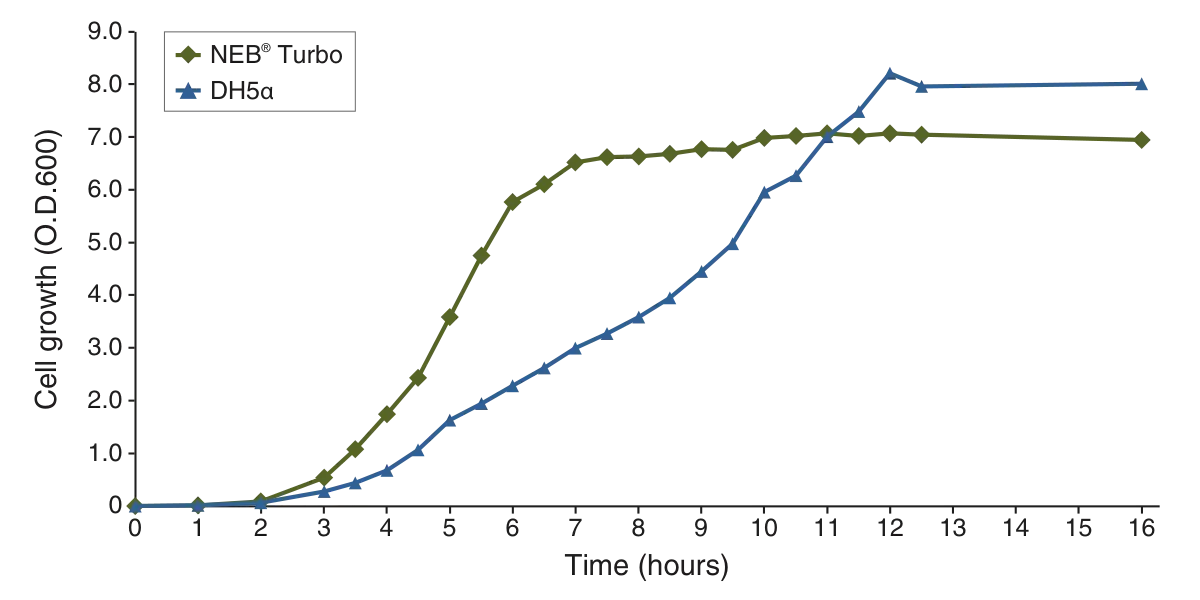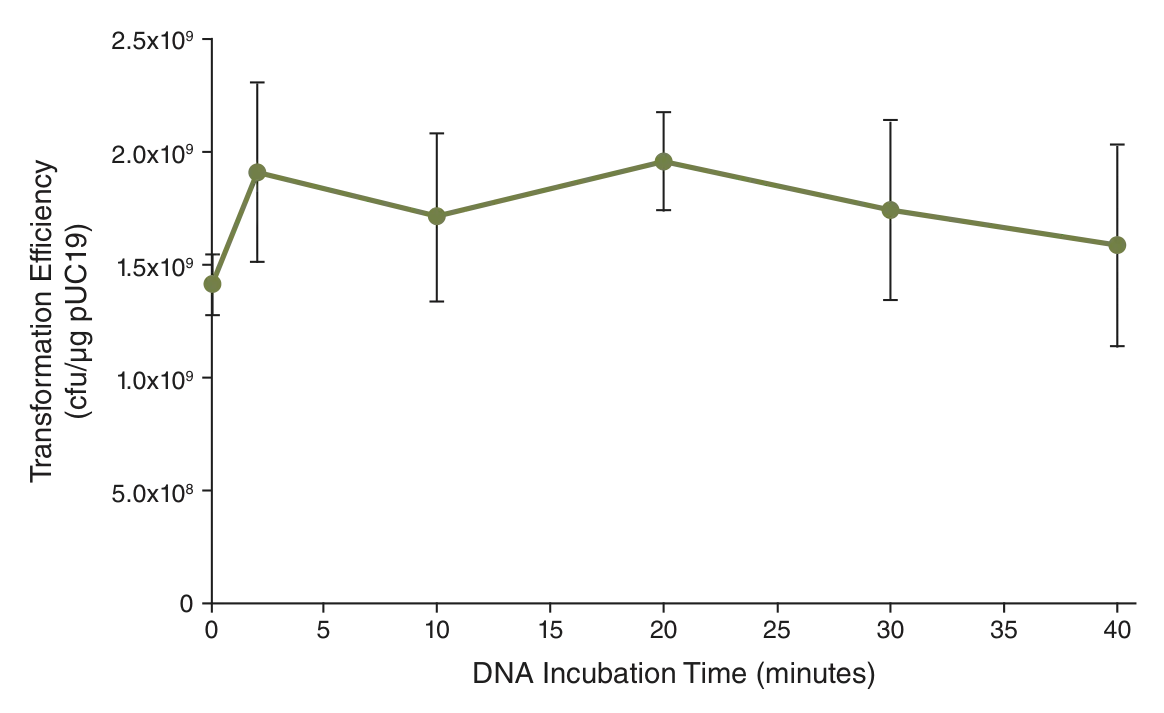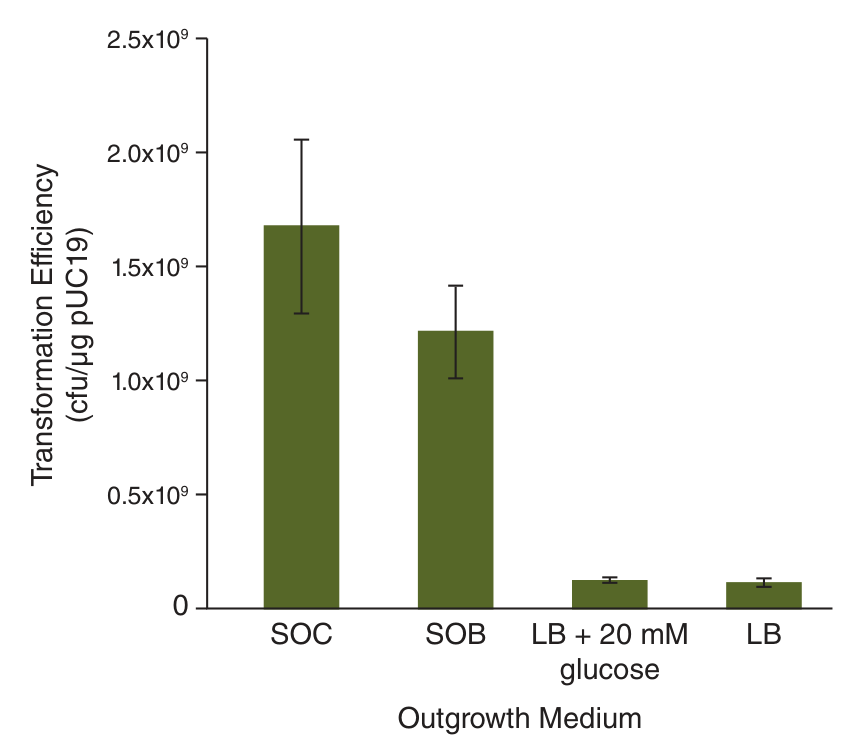NEB® Turbo Competent E. coli (High Efficiency)
Product information| Code | Name | Size | Quantity | Price | |
|---|---|---|---|---|---|
C2984I |
NEB Turbo Competent E. coli (High Efficiency) |
6 x 0.2 ml | - | Unavailable in your region | |
C2984H |
NEB Turbo Competent E. coli (High Efficiency) |
20 x 0.05 ml | - | Unavailable in your region |
NEB® Turbo Competent E. coli (High Efficiency)
Product Introduction
E. coli cells featuring fast colony growth (6.5 hours)
- Tight expression control (lacIq)
- Isolate DNA after only 4 hours of growth
- 5-minute transformation protocol with AmpR plasmids
- No dry ice surcharge on competent cell shipments
- Outgrowth medium included
- Free of animal products
| Catalog # | Size | Concentration |
|---|---|---|
| C2984H | 20 x 0.05 ml | |
| C2984I | 6 x 0.2 ml |
Featured Videos
View Video Library- Product Information
- Protocols, Manuals & Usage
- Tools & Resources
- FAQs & Troubleshooting
- Citations & Technical Literature
- Quality, Safety & Legal
- Other Products You May Be Interested In
Product Information
Description
Highlights
- Tight control of expression by laclq allows potentially toxic genes to be cloned
- Highest growth rate on agar plates - visible colonies 6.5 hours after transformation
- Activity nonspecific endonuclease I (endA1) eliminated for highest quality plasmid preparations
- Resistance to phage T1 (fhuA2)
- Suitable for blue/white screening by α-complementation of the β-galactosidase gene
- Suitable for 5 minute transformation protocol with AmpR plasmids
- EcoKr-m-, McrBC-
- K12 Strain
- Isolate DNA after 4 hours of growth from a single overnight colony
- Free of animal products
Transformation Efficiency
1 - 3 x 109 cfu/μg pUC19 DNA Chemically competent E. coli cells suitable for high efficiency transformation and rapid colony growth.Genotype
F' proA+B+ lacIq ∆lacZM15 / fhuA2 ∆(lac-proAB) glnV galK16 galE15 R(zgb-210::Tn10)TetS endA1 thi-1 ∆(hsdS-mcrB)5
- This product is related to the following categories:
- Cloning Competent Cell Strains
- This product can be used in the following applications:
- High-throughput cloning and automation solutions,
- Transformation,
- Fast Cloning: Accelerate your cloning workflows with reagents from NEB
Reagents Supplied
Reagents Supplied
The following reagents are supplied with this product:
| NEB # | Component Name | Component # | Stored at (°C) | Amount | Concentration | |||||||||||||||||||||||||
|---|---|---|---|---|---|---|---|---|---|---|---|---|---|---|---|---|---|---|---|---|---|---|---|---|---|---|---|---|---|---|
| ||||||||||||||||||||||||||||||
| ||||||||||||||||||||||||||||||
Properties & Usage
Antibiotic for Plasmid Selection
| Antibiotics for Plasmid Selection | Working Concentration |
|---|---|
| Ampicillin | 100 µg/ml |
| Carbenicillin | 100 µg/ml |
| Chloramphenicol | 33 µg/ml |
| Kanamycin | 30 µg/ml |
| Streptomycin | 25 µg/ml |
| Tetracycline | 15 µg/ml |
Shipping Notes
- Ships on dry ice
Antibiotic Resistance
- nit
Features
- Fastest growth – colonies visible after 6.5 hours
- Plasmid preparation after 4 hours
- Tight control/expression of toxic genes (F´lacIq)
Application Features








Related Products
Companion Products
- dam-/dcm- Competent E. coli
- NEB® 10-beta Competent E. coli (High Efficiency)
- NEB® 5-alpha Competent E. coli (High Efficiency)
- NEB® 5-alpha F' Iq Competent E. coli (High Efficiency)
Materials Sold Separately
Product Notes
- CAUTION: This product contains DMSO, a hazardous material. Review the MSDS before handling.
- STORAGE AND HANDLING: Competent cells should be stored at -80°C. Storage at -20°C will result in a significant decrease in transformation efficiency. Cells lose efficiency whenever they are warmed above -80°C, even if they do not thaw.
Protocols, Manuals & Usage
Protocols
Usage & Guidelines
Application Notes
Tools & Resources
Selection Charts
Web Tools
FAQs & Troubleshooting
FAQs
- Which competent cell strains are compatible with Gateway® Cloning?
- Does plasmid size affect colony size (C2984)?
- How long can I purify plasmid after the inoculation from a single colony using NEB Turbo competent E.coli (C2984)?
- How long should I incubate cells on ice after DNA has been added (NEB #C2984H and NEB #C2984I)?
- What are the strain properties (C2984)?
- What does the growth curve of NEB Turbo cells look like compared to DH5α?
- What is the difference between NEB #C2984H and NEB #C2984I?
- What is the optimal heat shock time for this strain (NEB #C2984H and NEB #C2984I)?
- Which strain of Competent E.coli should I use for general cloning?
- How should I calculate the transformation efficiency (C2984)?
- What are the solutions/recipes (C2984)?
- Can I store competent cells at -20°C instead of -80°C?
- Which kind of transformation tubes should be used?
- What volume of DNA can be added into competent cells?
- What is the shelf life for this strain (NEB #C2984H and NEB #C2984I)?
- Are NEB's competent cells compatible with the “Mix & Go" protocol?
- How should I store SOC Outgrowth Medium? The SOC I received with my competent cells recommends storage at either room temperature or 4°C, however, when I purchase it as a stand alone product, it recommends storing it at 4°C. Which is better?
- How should fragments be prepared for assembly using NEBuilder HiFi?
- Are NEB Turbo Competent E. coli (High Efficiency) or NEB Turbo Electrocompetent E. coli recommended for cloning repetitive or unstable DNA?
Citations & Technical Literature
Citations
Additional Citations
Quality, Safety & Legal
Quality Assurance Statement
Quality Control tests are performed on each new lot of NEB product to meet the specifications designated for it. Specifications and individual lot data from the tests that are performed for this particular product can be found and downloaded on the Product Specification Sheet, Certificate of Analysis, data card or product manual. Further information regarding NEB product quality can be found here.Specifications
The Specification sheet is a document that includes the storage temperature, shelf life and the specifications designated for the product. The following file naming structure is used to name these document files: [Product Number]_[Size]_[Version]Certificate Of Analysis
The Certificate of Analysis (COA) is a signed document that includes the storage temperature, expiration date and quality controls for an individual lot. The following file naming structure is used to name these document files: [Product Number]_[Size]_[Version]_[Lot Number]- C2984H_I_v1_1501607
- C2984H_I_v1_1511607
- C2984H_I_v1_1491608
- C2984H_I_v1_1531608
- C2984H_I_v1_1541609
- C2984H_I_v1_1551609
- C2984H_I_v1_1441609
- C2984H_I_v1_1531610
- C2984H_I_v1_1561610
- C2984H_I_v1_1571610
- C2984H_I_v1_1511610
- C2984H_I_v1_1511611
- C2984H_I_v1_1571612
- C2984H_I_v1_1581612
- C2984H_I_v1_1591612
- C2984H_I_v1_1541612
- C2984H_I_v1_1601612
- C2984H_I_v1_1611612
- C2984H_I_v1_1541701
- C2984H_I_v1_1621701
- C2984H_I_v1_1631701
- C2984H_I_v1_1531702
- C2984H_I_v1_1561701
- C2984H_I_v1_1481703
- C2984H_I_v1_1581703
- C2984H_I_v1_1481704
- C2984H_I_v1_1611704
- C2984H_I_v1_1641704
- C2984H_I_v1_1651704
- C2984H_I_v1_1631705
- C2984H_I_v1_1661705
- C2984H_I_v1_1671705
- C2984H_I_v1_1481706
- C2984H_I_v1_1671706
- C2984H_I_v1_1621707
- C2984H_I_v1_1641707
- C2984H_I_v1_1651707
- C2984H_I_v1_1651708
- C2984H_I_v1_1651710
- C2984H_I_v1_1661710
- C2984H_I_v1_1681707
- C2984H_I_v1_1691707
- C2984H_I_v1_1691708
- C2984H_I_v1_1711710
- C2984H_I_v1_1681711
- C2984H_I_v1_1651711
- C2984H_I_v1_1721711
- C2984H_I_v1_1731711
- C2984H_I_v1_1741712
- C2984H_I_v1_1751712
- C2984H_I_v1_1651712
- C2984H_I_v1_1741801
- C2984H_I_v1_1731802
- C2984H_I_v1_1761802
- C2984H_I_v1_1771802
- C2984H_I_v1_1721802
- C2984H_I_v1_1731803
- C2984H_I_v1_1771803
- C2984H_I_v1_1791803
- C2984H_I_v1_1461605
- C2984H_I_v1_1781803
- C2984H_I_v1_1731805
- C2984H_v1_10010693
- C2984I_v1_10011535
- C2984H_v1_10013993
- C2984I_v1_10014834
- C2984H_v1_10016261
- C2984I_v1_10018137
- C2984H_v1_10019406
- C2984I_v1_10020247
- C2984H_v1_10021754
- C2984I_v1_10023816
- C2984H_v1_10024959
- C2984H_v1_10027602
- C2984I_v1_10027741
- C2984H_v1_10029668
- C2984I_v1_10030695
- C2984H_v1_10032173
- C2984H_v1_10033404
- C2984I_v1_10032815
- C2984I_v1_10034315
- C2984H_v1_10035216
- C2984H_v1_10036090
- C2984I_v1_10036849
- C2984H_v1_10039041
- C2984H_v1_10040972
- C2984I_v1_10040974
- C2984I_v1_10043316
- C2984H_v1_10043314
- C2984I_v1_10044706
- C2984H_v1_10045044
- C2984I_v1_10046065
- C2984H_v1_10046621
- C2984I_v1_10046511
- C2984H_v1_10048780
- C2984I_v1_10048236
- C2984H_v1_10049967
- C2984I_v1_10051191
- C2984H_v1_10052219
- C2984I_v1_10054061
- C2984H_v1_10056115
- C2984I_v1_10056965
- C2984H_v1_10054534
- C2984I_v1_10057865
- C2984H_v1_10058465
- C2984I_v1_10059457
- C2984H_v1_10060353
- C2984H_v1_10063268
- C2984I_v1_10063870
- C2984I_v1_10066622
- C2984H_v1_10067338
- C2984I_v1_10069277
- C2984H_v1_10069848
- C2984I_v1_10070559
- C2984H_v1_10075874
- C2984I_v1_10076324
- C2984H_v1_10076859
- C2984I_v1_10077817
- C2984H_v1_10078653
- C2984I_v1_10079408
- C2984H_v1_10080360
- C2984I_v1_10081582
- C2984H_v1_10081583
- C2984H_v1_10083742
- C2984I_v1_10083743
- C2984H_v1_10084675
- C2984H_v1_10086605
- C2984I_v1_10086607
- C2984H_v1_10090649
- C2984I_v1_10090062
- C2984I_v1_10093945
- C2984H_v1_10094450
- C2984I_v1_10096414
- C2984H_v1_10099035
- C2984I_v1_10099670
- C2984H_v1_10103122
- C2984I_v1_10103123
- C2984H_v1_10106267
- C2984I_v1_10106268
- C2984H_v1_10110020
- C2984I_v1_10112537
- C2984H_v1_10113638
- C2984I_v1_10115830
- C2984H_v1_10115835
- C2984H_v1_10119155
- C2984I_v1_10119156
- C2984H_v1_10120659
- C2984I_v1_10122033
- C2984H_v1_10125858
- C2984H_v1_10129892
- C2984I_v1_10130885
- C2984H_v1_10135118
- C2984I_v1_10136209
- C2984H_v1_10141118
- C2984I_v1_10142629
- C2984H_v1_10145208
- C2984I_v1_10146264
- C2984H_v1_10148283
- C2984H_v1_10151208
- C2984I_v1_10153045
- C2984H_v1_10156079
- C2984I_v1_10156726
- C2984H_v1_10158431
- C2984I_v1_10161437
- C2984H_v1_10162571
- C2984I_v1_10164684
- C2984H_v1_10166319
- C2984H_v1_10170206
- C2984I_v1_10169696
- C2984H_v1_10172941
- C2984I_v1_10173929
- C2984H_v1_10176988
- C2984I_v1_10178073
- C2984H_v1_10180240
- C2984I_v1_10181370
- C2984H_v1_10184369
- C2984I_v1_10185388
- C2984H_v1_10188359
- C2984I_v1_10192308
- C2984H_v1_10194646
- C2984I_v1_10197242
- C2984H_v1_10198911
- C2984I_v1_10202696
- C2984H_v1_10203042
- C2984H_v1_10206702
- C2984I_v1_10206696
- C2984H_v1_10211002
- C2984H_v1_10215316
- C2984H_I_v1_1611710
- C2984H_v1_10222323
- C2984I_v1_10223306
- C2984I_v1_10228558
- C2984H_v1_10229109
- C2984H_v1_10233251
- C2984H_v1_10236688
- C2984I_v1_10237222
- C2984H_v1_10240695
- C2984I_v1_10217654
- C2984I_v1_10243500
- C2984H_v1_10243501
- C2984I_v1_10248374
- C2984H_v1_10248372
- C2984H_v1_10253521
- C2984I_v1_10254826
- C2984I_v1_10258659
- C2984H_v1_10261166
- C2984H_v1_10264130
- C2984I_v1_10267489
- C2984H_v1_10269519
- C2984H_v1_10274503
- C2984I_v1_10274504
- C2984H_v1_10277747
- C2984I_v1_10282795
- C2984H_v1_10285466
- C2984I_v1_10291312
- C2984H_v1_10296073
- C2984H_v1_10301487
- C2984I_v1_10302513
- C2984H_v1_10304549
- C2984H_v1_10309471
- C2984I_v1_10311717
Safety DataSheets
The following is a list of Safety Data Sheet (SDS) that apply to this product to help you use it safely.NEB® Turbo Competent E. coli (High Efficiency)
pUC19 Vector
SOC Outgrowth Medium
Legal and Disclaimers
Products and content are covered by one or more patents, trademarks and/or copyrights owned or controlled by New England Biolabs, Inc (NEB). The use of trademark symbols does not necessarily indicate that the name is trademarked in the country where it is being read; it indicates where the content was originally developed. The use of this product may require the buyer to obtain additional third-party intellectual property rights for certain applications. For more information, please email [email protected].This product is intended for research purposes only. This product is not intended to be used for therapeutic or diagnostic purposes in humans or animals.
New England Biolabs (NEB) is committed to practicing ethical science – we believe it is our job as researchers to ask the important questions that when answered will help preserve our quality of life and the world that we live in. However, this research should always be done in safe and ethical manner. Learn more.
Other Products You May Be Interested In
The supporting documents available for this product can be downloaded below.









